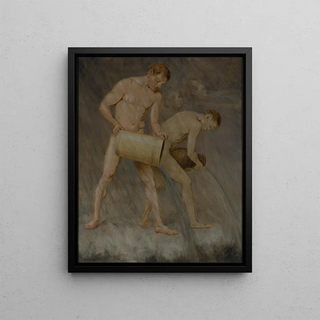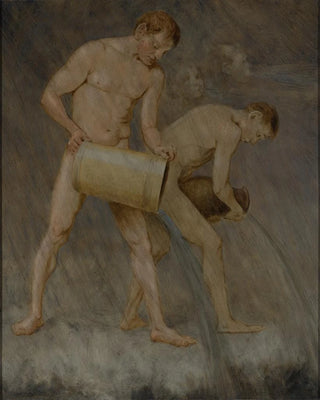Art print | November the rain gods - Hans Thoma


View from behind

Frame (optional)
In the fascinating world of art, some works transcend time and space, captivating viewers with their beauty and depth. "November the rain gods - Hans Thoma" is a perfect example. This canvas, rich in symbolism and emotion, evokes the intensity of seasons and the connection between man and nature. By immersing oneself in this pictorial universe, one discovers a painting that invites reflection and wonder, where each brushstroke seems to whisper ancient stories and forgotten legends. The depiction of rain, omnipresent and invigorating, becomes the guiding thread of a visual narrative that touches on the very essence of life.
Style and uniqueness of the work
Hans Thoma's style is characterized by a harmonious fusion of reality and the fantastical. In "November the rain gods," he manages to capture the melancholic atmosphere of autumn while infusing a mythological dimension into his work. The colors, both dark and luminous, create a striking contrast that draws the eye and invites exploration. Thoma plays with light in a masterful way, paying tribute to the subtle nuances of nature during this transitional season. The rain, depicted as a divine force, seems to dance across the canvas, bringing a unique dynamism to the whole. Every character, every landscape element is carefully arranged to tell a story, that of a dialogue between man and the elements, between the sacred and the profane.
The artist and his influence
Hans Thoma, an emblematic figure of the symbolist movement, knew how to mark his era with an innovative approach to painting. Born in 1839 in Germany, he was influenced by the great masters of Romantic painting while developing a personal style that is uniquely his own. His work is often imbued with a deep respect for nature and folk traditions, elements that are reflected in "November the rain gods." Thoma captured the spirit of the times, blending elements of Germanic mythology with modern sensibility. His influence endures, inspiring many contemporary artists who see in him a pre

Matte finish

View from behind

Frame (optional)
In the fascinating world of art, some works transcend time and space, captivating viewers with their beauty and depth. "November the rain gods - Hans Thoma" is a perfect example. This canvas, rich in symbolism and emotion, evokes the intensity of seasons and the connection between man and nature. By immersing oneself in this pictorial universe, one discovers a painting that invites reflection and wonder, where each brushstroke seems to whisper ancient stories and forgotten legends. The depiction of rain, omnipresent and invigorating, becomes the guiding thread of a visual narrative that touches on the very essence of life.
Style and uniqueness of the work
Hans Thoma's style is characterized by a harmonious fusion of reality and the fantastical. In "November the rain gods," he manages to capture the melancholic atmosphere of autumn while infusing a mythological dimension into his work. The colors, both dark and luminous, create a striking contrast that draws the eye and invites exploration. Thoma plays with light in a masterful way, paying tribute to the subtle nuances of nature during this transitional season. The rain, depicted as a divine force, seems to dance across the canvas, bringing a unique dynamism to the whole. Every character, every landscape element is carefully arranged to tell a story, that of a dialogue between man and the elements, between the sacred and the profane.
The artist and his influence
Hans Thoma, an emblematic figure of the symbolist movement, knew how to mark his era with an innovative approach to painting. Born in 1839 in Germany, he was influenced by the great masters of Romantic painting while developing a personal style that is uniquely his own. His work is often imbued with a deep respect for nature and folk traditions, elements that are reflected in "November the rain gods." Thoma captured the spirit of the times, blending elements of Germanic mythology with modern sensibility. His influence endures, inspiring many contemporary artists who see in him a pre






